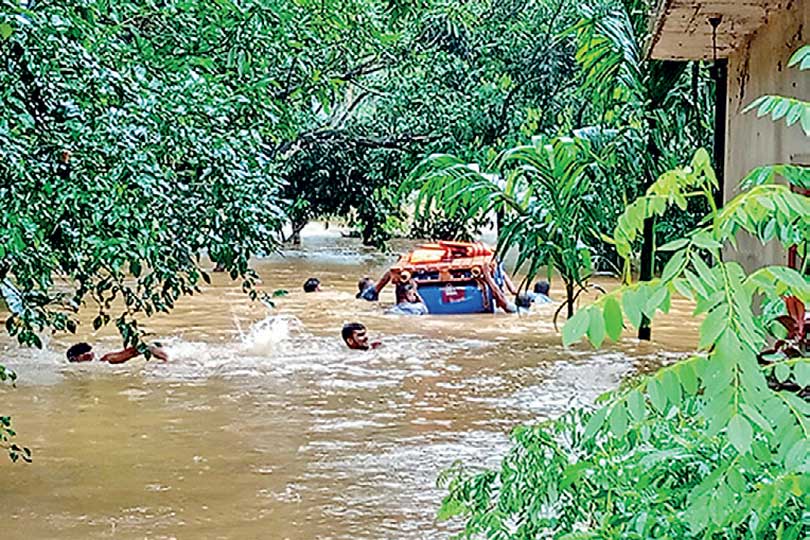Monday Apr 07, 2025
Monday Apr 07, 2025
Tuesday, 4 June 2024 02:12 - - {{hitsCtrl.values.hits}}

By Charumini de Silva
|
State Minister of Defence Premitha Bandara Tennakoon
Meteorology Department Director-General |
State Minister of Defence Premitha Bandara Tennakoon yesterday announced that the Government will implement stringent regulations to mitigate the impact from natural disasters, including the introduction of a dry dam solution, a new building code and a comprehensive policy on tree planting along roadsides.
Speaking at a special media briefing organised by the Government Information Department, he stressed the importance of the regulations for public safety, noting that the neglect of these rules has led to rising costs in relief efforts during natural disasters.
“These rules and regulations have been introduced for the protection of the public, which has been ignored for years, and the cost of relief efforts during natural calamities is rising rapidly each year. Thus, strict laws and measures will definitely be implemented,” Tennakoon stated.
He cited Bangladesh’s flood mitigation measures as a model for Sri Lanka to follow.
Tennakoon highlighted the proposed dry dam solution particularly for Ratnapura district, which has been recommended by experts for many years but has not been implemented due to high costs. “The Government will consider this solution seriously to reduce the increasing costs of post-disaster relief measures,” he added.
Additionally, Tennakoon announced the introduction of a Building Code to ensure the quality of construction for high-rise housing and other buildings. “It might not be an immediate concern, but with more people moving into high-rise buildings, it is crucial to ensure their safety and quality amid natural disasters,” he explained.
The State Minister also pointed out that, apart from most buildings in the Colombo District, many other districts do not adhere to building permits and regulations set by the NBRO, Urban Development Authority (UDA), Meteorology Department, Disaster Management Division, Provincial Councils and other State agencies.
Tennakoon highlighted the need for a policy on planting trees along roadsides. “In Colombo alone, there are 100,000 trees, with 300 identified by the Colombo Municipal Council (CMC), Sri Lanka Army and Sri Lanka Civil Security Force as risky and prone to falling during severe weather conditions,” he asserted.
He also revealed that the modernisation of the Meteorology Department is in progress, funded by the World Bank and supported by technical assistance from the Japan International Cooperation Agency (JICA). “Despite the economic crisis, this project continued as the Government prioritised it. The revamp aims to improve climate-related predictions by the Met Department and to take precautionary measures to minimise impact. The project is expected to begin civil construction in August and complete by 2026,” he added.
Tennakoon said the modernisation of the Meteorology Department is a comprehensive and significant step towards Government’s broader strategy to enhance disaster preparedness and resilience in the face of increasing natural calamities.
Meteorology Department Director General Athula Karunanayake stated that the current weather forecasting system is inadequate and measures are underway to upgrade it. “Currently, the department can only predict up to 150mm of rain,” he said.
He also disclosed plans to acquire a Doppler weather radar, which is used to locate precipitation, track its movement, and estimate its type (rain, snow, hail, etc.). “We anticipate receiving the Doppler system soon as a gift from JICA,” Karunanayake added. He noted that this radar will allow the Met Department to provide evidence-based forecasts, better informing the public before impacts occur to minimise loss of life and economic damage.
However he said that Sri Lanka would need at least two such radar systems in Puttalam and Potuvil which helps to gather information covering the two regions from the Arabian Sea and the Indian Ocean.
Discover Kapruka, the leading online shopping platform in Sri Lanka, where you can conveniently send Gifts and Flowers to your loved ones for any event including Valentine ’s Day. Explore a wide range of popular Shopping Categories on Kapruka, including Toys, Groceries, Electronics, Birthday Cakes, Fruits, Chocolates, Flower Bouquets, Clothing, Watches, Lingerie, Gift Sets and Jewellery. Also if you’re interested in selling with Kapruka, Partner Central by Kapruka is the best solution to start with. Moreover, through Kapruka Global Shop, you can also enjoy the convenience of purchasing products from renowned platforms like Amazon and eBay and have them delivered to Sri Lanka.
Discover Kapruka, the leading online shopping platform in Sri Lanka, where you can conveniently send Gifts and Flowers to your loved ones for any event including Valentine ’s Day. Explore a wide range of popular Shopping Categories on Kapruka, including Toys, Groceries, Electronics, Birthday Cakes, Fruits, Chocolates, Flower Bouquets, Clothing, Watches, Lingerie, Gift Sets and Jewellery. Also if you’re interested in selling with Kapruka, Partner Central by Kapruka is the best solution to start with. Moreover, through Kapruka Global Shop, you can also enjoy the convenience of purchasing products from renowned platforms like Amazon and eBay and have them delivered to Sri Lanka.